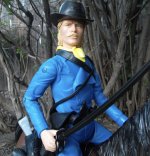Like everyone, I have an opinion. Naming a county, town and state park
after a person who killed old men, women and children in their winter
camp during a blizzard. That sounds like a poke in the eye to the native
Americans in that local...
I've seen bumper stickers in that part of Oklahoma that said, "Custer had
it coming". I agree!
Just to be clear, the Battle of Little Big Horn in Montana occurred on June 25-26, 1876. It clearly wasn’t a winter camp. Custer also didn’t intentionally kill women and children. But it’s a fine point. It seems very likely he was intending to ride around the north end of the encampment while the braves were busy engaging Reno at the south end of the valley, and once there would have basically held the women and children hostage to get the warriors to lay down their arms. That had been done in the past when attempting to bring Indians back to the reservation.
It’s also clear Custer was a glory seeking idiot who ignored his scouts, badly underestimated the size of the force against him, exceeded his orders, left behind his Gatling guns in order to move faster and win the engagement before the other prongs of the larger campaign arrived, and split his forces during the battle, pretty much dooming his command.
The irony is that Reno and to a lesser extent Bentsen were blamed for much of the failure. However, if you ever visit the battle field and actually walk the ground, particularly the south end of the valley where Reno and Benteen held out, you’ll realize that Reno found, fell back to and held the only defensible position for miles. It had steep draws to the south and west and a wide open field of fire for 1000 yards to the east and for a similar distance to the north. The only vulnerability was the high ground to the north from which they were sniped at over the next couple days, but that had minimal effect once they dug in.
——
I assume you are instead referring to the Wounded Knee Massacre that occurred on December 29, 1890, 14 and a half years after Custer died. The 7th Cavalry was there, but was commanded by Colonel Forsyth. He happened upon the scene after a detachment commanded by Major Whitside had them on their way back to the reservation. Whitside had the good sense not to try to disarm them as that would lead to violence. Forsyth lacked that good sense and ordered them disarmed. A scuffle, an accidental discharge and a total loss of control of the troops led to the massacre.
——-
Custer’s role in the Black Hills had to do with his leading a survey expedition to the Black Hills in July and August of 1874. Custer entered the Black Hills from the north and traveled to the Harney/Black Elk peak area before establishing a camp near present day Custer SD (about 7 miles south west of the peak).
The expedition itself was in part to seek a suitable location for a forest and route south west through the Black Hills. It was also intended to address rumors of gold in the Black Hills. Gold was found in the creeks in the northern Black Hills as well as in French Creek west of the camp Custer established south west of Harney peak.
Finding/confirming gold in the Black Hills prompted a gold rush in 1874-76 that brought a flood of whites into the Black Hills, which had been ceded to the Sioux by the Fort Laramie treaty in 1868. That of course angered the Sioux and led pretty much directly to the war in 1876.
In that regard, the camp Custer established was named after Custer during the 1874 expedition, and the town that grew from that was named after the camp. The park, with its western boundary about 5 miles east of the town, was named after General Custer, but somewhat indirectly. If the town of Custer hadn’t been where it is, the park would have probably been named after someone else.


